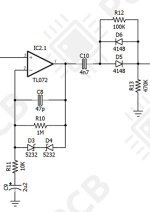UtilityBeltFX
Well-known member
What is the proper power supply for the PedalPCB Valhalla (Diezel VH4)? The original pedal uses 12-18v and I'm having a little trouble verifying what Rob's version wants.
wants.
Thank you!
Thank you!
Do you think this is harmful in any way? Or more just like running it in a low headroom mode. Less dynamics/more distortion?I can confirm that it will work with 9V and 12V, but the internal voltage rails will not be +12V and -12V as designed.
That's why 18V (or anything over 14~15V) is ideal for the best dynamic response of the distortion. This design has a main clipping stage with a unique topology that needs the full voltage excursion to work best.
It’s not harmful, but yes exactly that, lower headroom and less dynamic, it definitely preforms its best at full proper voltage for my money. More “amp like” for lack of a better term, but it’s convenient to be able to run in at lower voltages if those taps are being tied up by a pedal than can’t operate on lower voltages or don’t have a power supply that has a 12v or an 18v tap. It’s a nice project that is a full featured preamp that is relatively easy to build.Do you think this is harmful in any way? Or more just like running it in a low headroom mode. Less dynamics/more distortion?

This is all true but my speakers and ears don’t seem to know that.With an input over 15V, the 78L12 regulator will work correctly and the circuit will have +12V and -12V power rails. With these, the TL072 opamp should have a max peak to peak output voltage of about 21 Volts.
But with an 9V input, the rails will probably be about +8V and -8V, giving a max peak to peak output voltage of about 13 Volts in the op amps.
Let's look at the clipping stage (since the clipping is symmetric, I will analyze peak voltage generically):
View attachment 73226
The clipping zeners 1N5232 in the feedback loop have a threshold voltage of 5.6V. Add to that the 0.65V drop from the forward biased zener in series.
The output of the opamp will start showing soft clipping when the peaks are over 6.3V. The current of the diodes when conducting is small enough to give a soft transition at threshold voltage (10k current limiting resistor).
When the opamp output is under 6.3V, the stage gain is -101 (about +40dB). Over 6.3V, the stage gain will slowly decrease down to -1 (0dB). The waveshape of this topology will probably behave similar to a tube screamer at max gain.
Then, at the output of the opamp there's a resistor voltage divider with some diodes (I'm ignoring the C10 hi-pass filter in 60Hz for the analysis).
The 4148 diodes will start conducting when the voltage drop on the 100K resistor is about 0.65V, and that will happen when the opamp output is about 3.7V. The current of the diodes is very small when conducting, and it will give a very soft transitions at threshold voltage (470k current limiting resistor).
When the opamp output is under 3.7V, the voltage divider gain is 0.82 (-1.7dB). Over 3.7V, the voltage divider gain will slowly increase 1 (0dB). The waveshape here is a bit of an expander, but -1.7dB is not much really, so I'm not sure how much this will actually affect the final sound.
Considering that the zeners soft clipping will dictate the main distortion shape of the stage, for the soft clipping to work correctly you will need an opamp excursion of a few volts over 6.3V.
With an 18V power supply the opamp will clip at about 10.5V, giving a good soft clipping excursion before opamp hard clipping.
But with a 9V power supply, the opamp will clip at about 6.5V, making the main source of distortion at this stage the opamp hard clipping, which is a lot harsher (lots of high order harmonics).
I may have missed something along the way, but that's about it.
